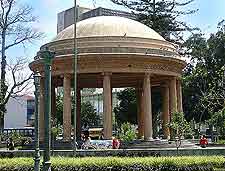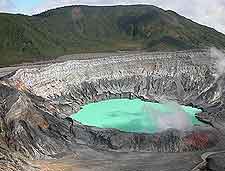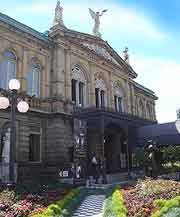San Jose History Facts and Timeline
(San Jose, Costa Rica)

As one of the youngest capitals in the region, San Jose's history is not extensive. It pales in comparison to nearby
Cartago and is a thoroughly modernised centre of industry today. However, it is Costa Rica's largest city and retains a number of monuments of yesteryear, with several worthwhile historic attractions.
Founding of the City
Though San Jose is historically much younger than Cartago, people were living in the area when the rest of the Central Plateau was being settled by Spanish folk in general, around the middle of the 16th century. They settled in the Aserri Valley, to the south, and were then moved to Boca del Monte in 1736, where Saint Joseph's Church was completed just two years later, a site located near the Central Bank of today.
The city was born in 1738, although it was not yet a capital and many folks refused to move here due to the scarcity of water. Even with piped-in water, by the mid-18th century, many people were still reluctant to commit to living here. The town grew slowly, however, but that changed by the time San Jose became the capital of a new independent Costa Rica, in the year of 1823.
Costa Rican Independence
San Jose gained this status when Cartago wanted to join the Mexican Empire, following the defeat of the Spanish. A brief civil war ensued, although republic-inspired San Jose won through. The population reached 15,000 by the middle of the 1820s, although San Jose's popularity and new-found status rather angered nearby cities, who formed an organisation in 1837 and plotted to overthrow the government. The city made history by being victorious in the subsequent 'La Guerra de la Liga' (the League War) and it remained the capital.

Coffee Boom
The coffee industry brought much affluence and hope to an otherwise poor, and somewhat neglected (by the Spanish) Costa Rica. The area around San Jose became littered with plantations, which continue to this day and transformed the village into an attractive city with paved roads, illuminated streets and modern tramways.
By the 1900s, there were fine buildings, squares (plazas), libraries and museums. The stunning Teatro Nacional (the classical Renaissance-style three-tiered National Theatre) was built in the 1890s and still serves as one of the city's highlights.
People were now attracted to San Jose from all around, being drawn by its considerable wealth and the potential that it offered for a better way of life. However, as with elsewhere in South America, most would end up living in slums (including segregated areas for blacks) punctuated by industrial zones.

Post War History to Today
Despite the wealth from coffee, San Jose had fewer than 100,000 residents by the 1940s, although it expanded its boundaries dramatically after the end of the Second World War, swallowing up adjacent towns such as Guadalupe. This breakneck expansion saw a number of attractive, historic buildings demolished and ugly concrete structures erected in their place. Earthquakes have also blighted the urban landscape of San Jose, while the nearby Irazu Volcano blew its top in 1963, covering the city in a layer of ash.
Today, the city and province of San Jose are the most populous in the country, with many industries in the suburbs and people from all around commuting to work here, including from Cartago. It is, consequently, the country's most modern urban centre and has the best facilities. Tourists also come to see its monuments in Morazán Park - including the Temple of Music (Templo de Música) - and the Plaza de la Cultura (Culture Plaza), which contains the National Theatre and several museum-type attractions, where visitors can learn about the history of San Jose.
 As one of the youngest capitals in the region, San Jose's history is not extensive. It pales in comparison to nearby Cartago and is a thoroughly modernised centre of industry today. However, it is Costa Rica's largest city and retains a number of monuments of yesteryear, with several worthwhile historic attractions.
As one of the youngest capitals in the region, San Jose's history is not extensive. It pales in comparison to nearby Cartago and is a thoroughly modernised centre of industry today. However, it is Costa Rica's largest city and retains a number of monuments of yesteryear, with several worthwhile historic attractions.
